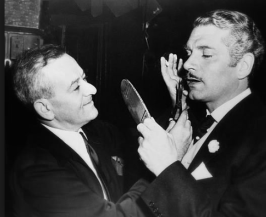
She spent 5 months editing footage
Leni Riefenstahl was hired by Hitler himself to produce a film that glorified the Nazi party, and she delivered in spectacular fashion. She needed 30 cameras to capture the pageantry of 1934’s week-long, 700,000-strong Nuremberg Rally. The result is Triumph of the Will, a film as tightly controlled and rhythmically beautiful as the paramilitary troops who march and salute on the grand stage of the arena designed by Albert Speer. Her masterful edit of the rich variety of images creates a film that ebbs and swells like a symphony. When it concludes, you will recall with surprise that, but for the rousing speeches by Hitler and others, it is pure cinema– a sweeping array of images with music, but not one word of narration.

“crooks and murderers”
Why, then, was the film described as “the most marvelous anti-Nazi propaganda” by the great film critic Dwight Macdonald? In his words:
“When I saw all those people shouting Heil Hitler and Sieg Heil, I thought this is menacing and sinister. Those close-ups– the porky, beefy, misshapen faces of the Nazi leaders, they are the faces of a bunch of crooks and murderers– you can see that… There were some shots of Goering and Goebbels that you couldn’t possibly admire. Nobody but a Nazi could admire these people.” (From “Interviews with Dwight Macdonald,” University Press of Mississippi, 2003).

Armed and Aryan
His conclusion was that Riefenstahl was “so good a director that she produces truth even when she wants to produce lies.”
When I watched “Triumph of the Will” again recently, I realized how strong Macdonald’s words were. My heart hardened against what I was seeing, even though it was meant to glorify– the frank close-ups of the stolid faces of those high-and-mighty men, men who are staged as individuals standing tall against rows upon rows of those paramilitary troops, the handsomest of whom get their own sunlit close-ups. If you’re not one of them, if you’re not a German chauvinist, it is a chilling, frightening picture of imperial power and rank submission.













 Ironically, my dislike of Lombard is probably because she’s too good a comic actress. Her performances in movies like Mr. and Mrs. Smith and My Man Godfrey found me yearning for Jean Arthur or Claudette Colbert, actresses who could manage the eccentricities of the screwball heroine without becoming inane or irritating. But Lombard goes the whole screwball route. She makes Lucille Ball seem like Dame Judith Anderson.
Ironically, my dislike of Lombard is probably because she’s too good a comic actress. Her performances in movies like Mr. and Mrs. Smith and My Man Godfrey found me yearning for Jean Arthur or Claudette Colbert, actresses who could manage the eccentricities of the screwball heroine without becoming inane or irritating. But Lombard goes the whole screwball route. She makes Lucille Ball seem like Dame Judith Anderson.


